MOVIE REVIEWS |
INTERVIEWS |
YOUTUBE |
NEWS
|
EDITORIALS | EVENTS |
AUDIO |
ESSAYS |
ARCHIVES |
CONTACT
|
PHOTOS |
COMING SOON|
EXAMINER.COM FILM ARTICLES
||HOME


Tuesday, March 7, 2017
A CLOSER, LONGER LOOK/Get
Out
Do The White Thing
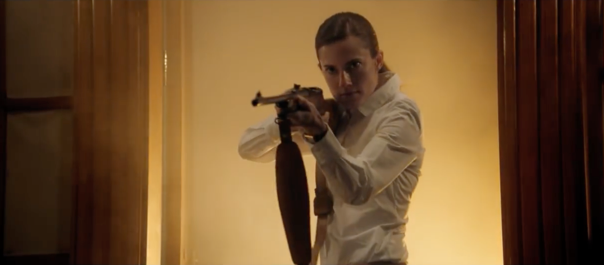
ALLY Get Your Gun: Allison Williams as Rose in
Jordan Peele’s debut film "Get
Out". Universal
by
Omar P.L. Moore/PopcornReel.com
 FOLLOW
FOLLOW
Tuesday,
March 7,
2017
GET OUT fires into racists and their racist fears around a Black man having an
intimate relationship with a white woman, among many other things, while
sighting primal territorial behavior, colonialism via optical symbols
SPOILERS AHEAD. Please see “Get Out” if you haven’t!
I am not a fan of horror films. There have been some excellent ones.
“Rosemary’s Baby”. “Night Of The Living Dead”. “Alien”. “Repulsion”.
“Psycho”. “The Shining”. "The Exorcist". Many others. But there’s a new
horror film I’ve now seen three times in a movie theater. I’ve seen it thrice
because it is a real, live horror I live - and a well-constructed,
thought-provoking entertainment.
It is 2017. Where white society and its power structure is concerned it is
always hunting season on Black people. The hunt is on. And the prey is
ensnared in so many ways symbolically, satirically and seriously in
Jordan
Peele’s top-class “Get Out”, the best film so far in early 2017.
Black people, race, imagery and animals in "Get Out" - and historical
context
“Get Out” isn’t just
timely, it is timeless. Mr. Peele’s film encapsulates American history as
Black people have experienced it vis-a-vis interactions with white people -
whether Emmett Till, Trayvon Martin,
Jordan Davis, Sandra Bland,
Renisha McBride, 12-year-old Tamir Rice, the
16th Street Baptist Church in Birmingham, Alabama, the
Emanuel AME Nine and many more. Each minded their own business and
lost their lives to racists - whites, or people who identified as white (George
Zimmerman). Few if any of the victims' murderers received justice.
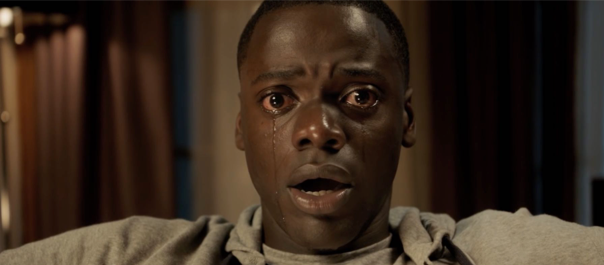
Daniel Kaluuya as Chris in Jordan Peele’s debut film "Get
Out". Universal
Animals have often if not always been placed in the pecking order above Black
people in America.
The United States Constitution once classified Blacks as
three-fifths of a human being. There are people who have received
longer prison sentences for harming animals than for killing Black people. This
history is inescapable. White society has demonized Black people via laws and
through
films, entertainment and media - as animals.
That language has been overt and coded, and "Get Out" leans to the
latter and mixes some of the former into its lexicon.
Some of the more recent language of racist coding: In 2008
LeBron James was on the cover of Vogue magazine with
Gisele Bunchen, in an image that was a racist stereotype of Black man
as animal - evoking imagery of a neo-“King Kong” basketballer, snaring a white
“supermodel”.
Countless white male and female celebrities, white
students and have appeared in Blackface either
on
screen or at Halloween parties or on college campuses across
America. Blackface remains something of an epidemic.
“Get Out” uses animal imagery (references to rabbits, cheetahs, birds, deer,
dogs and more) as endangered species and more than mere suggestion that Black
people are the prey of covetous, predatory white aristocrats and discreet
neo-slavery champions, all under the guise of white "limousine liberalism", the
kind that permeates places like Marin County, just across the Golden Gate
Bridge from San Francisco - and other so-called liberal and Progressive white
communities throughout the United States.
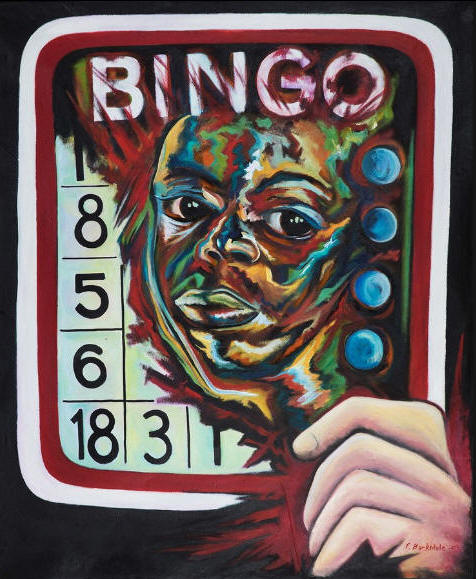
Artwork for "Get Out", commissioned by Jordan Peele.
Corey Barksdale
In “Get Out” Black people are seen as racist metaphors for animals - and so
often in white society and culture - the overwhelmingly white mainstream U.S.
media for example, branded the Black and Latino teenagers known as
The Central Park Five
as a “wolfpack” in 1989. Michael Brown was
described as a
"demon", “Hulk Hogan” with superhuman strength by Ferguson
police officer Darren Wilson, who killed the unarmed teenager as he held his
hands up. As Chris (Daniel
Kaluuya) is shuttled from the comfortable confines of his city
surroundings by white girlfriend Rose (Allison Williams) to white ruralism,
animal metaphors become more intense and inescapable. The atmosphere is primal
and feral. Chris’s identification with animals becomes more acute as the
scenery and environment around him changes.
The relationship between Chris and Rose, and a deeper truth beyond the
screen
Mr. Peele’s intelligent and deeply-layered film indicts casual racist comments
by white people in America while reaching a truth lying deep beneath about
stereotyped psychosexual dynamics in the relationship between
historically-oppressed classes: for some Black men when it comes to white women
every Rose has its thorn.
The most telling line of "Get Out" is spoken by Rose. It’s a line undergirding
that many but not all white women, when push comes to shove, will defend white
patriarchy as leverage to assimilate into that tragically flawed model - a model
which has treated white women with profound disrespect to say the least. When
white police officer Betty Shelby murdered
African-American Terence Crutcher as he had his hands up last September in Tulsa
she may well have done so to show her white male officer colleagues that she was
worthy of her place in Blue - in something akin to gang initiation rites.
But what was Shelby viewed as by her male colleagues before she killed?
Rose, on the surface is far less sinister yet more insidious in “Get Out”, at
least when on the phone with Rod (Lil
Rel Howrey), as she exhibits the fear and fantasy she projects about
white womanhood and her pedestaled desirability to Black men with choice words.
Rose then glances at her overly-ingratiating parents (Bradley Whitford as Dean;
Catherine Keener as Missy) shrouded in darkness, her words lingering in the
air. Rose’s parents and brother Jeremy (Caleb Landry Jones) approve of her
language. Any masks of politeness or pretension have now well and truly come
off - for good. The lingering fears are resplendently voiced and celebrated
with sly smiles. Rose, by the way, has been on the phone before in the
film early on, presumably to Jeremy.
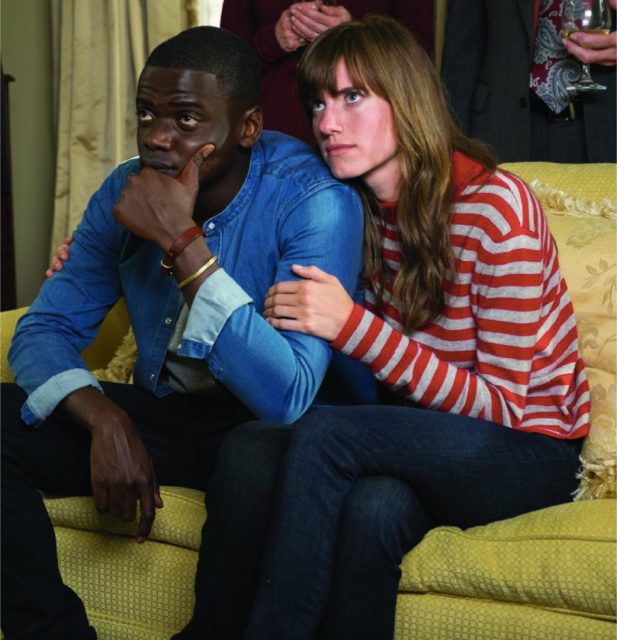
Bungle Fever And The Eyes Have It: Daniel Kaluuya as
Chris; Allison Williams as Rose in "Get
Out". Universal
Throughout Rose casually posits sexual innuendo about and toward Black men,
whether to Chris directly as they drive to her parents’ mansion, to him when at
her parents house, or to the aptly(?)-named Rod. In other words sexual innuendo
is the order of the day in "Get Out", like a wobbly anthem. The only thing I
was surprised at is that Rose didn’t mention how “tall, dark and handsome” Chris
is (another white woman at the mansion all but does so during a party.)
This psychosexual code plays throughout “Get Out”. The film’s principal white
women (Rose and Missy) relentlessly mind fuck Chris while its principal white
men (Dean and Jeremy) do the physical and literal heavy lifting. Missy looks at
Chris suggestively while Dean asks in an insulting, derisory and racist
sarcastic way, "how long has this thang been going on?"
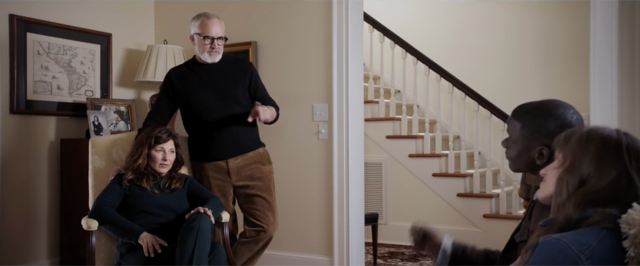
Guess Who's Coming To Dinner: Catherine Keener as Missy
and Bradley Whiford as Dean in "Get
Out". Universal
What “Get Out” posits is that the history between Black people and white people
in America has not only not been truly and openly explored but has been
done so if at all through awkward physical, sexual and coded channels in
American history. Any discussion of white self-anxiety or general,
intrinsically-rooted white anxiety about Blackness or Black people is vocalized
via sexual innuendo or comments about athleticism. (Dean, for example, with a
bitter politeness refers to Jesse Owens and his own father’s losing to Owens in
the 1930s. There’s envy, not ecstasy in Dean as he exults about Owens sticking
it to Hitler.)
There’s never a conversation a white person has with a Black person in “Get Out”
that doesn’t revolve around variables of physical dimension. White guests
approach Chris about his physicality, about racist sexual stereotypes - but
never talk to him or treat him as a human being or a
person. They objectify him at every turn. They compare him to athletes
like Tiger Woods, himself a Black man who has often dated white women. (I’m not
sure if Chris has dated a white woman prior to Rose.)
No one talks to Chris about his photography even though his camera (a third eye,
if you will) is forever present. Even during a dinner table conversation
Chris’s camera is situated right in front of Dean, who ignores it completely.
Also telling: we never see the images Chris shoots with his Canon 7D camera when
in suburbia. There are images on his cellphone however that are a key part of
the film. Betty Gabriel, who plays Georgina the maid, interferes with Chris's
phone. Ms. Gabriel, who is truly creepy in "Get Out", is indispensible to
it.
The film also satirizes Chris early on. The very first image the movie audience
sees of Chris is as a topless man, his dark, blue-black skin glistening, in a
mirror. He is applying white shaving cream to what already looks like a clean
shaven face. Is this Chris’s metaphorical white face mask? The director’s
signaling of one? Is it Chris’s performance mask before his white girlfriend
arrives? A mask for survival in white suburbia? (Several characters ask Chris
why he is so calm during clearly alarming episodes. This shaving cream could be
a cinematic device for Chris’s - and by extension other Black persons’ - coping
mechanism for enduring and handling racist comments and environments.)
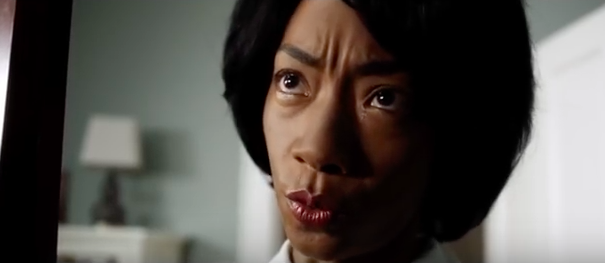
More Than Just The Help: Betty Gabriel as Georgina in
Jordan Peele’s debut film "Get
Out". Universal
Chris nicks his face through the shaving cream as if he has cut it with the
razor. This appears to be an early clue of what is to come. To borrow a line
from
“Bamboozled”: “Everyone wants to be Black but
nobody wants to be Black.” This line is operative in “Get Out” both literally
and figuratively: the white people who want to live forever want to live within
the body of a Black person. But those characters would rather colonize and
bodysnatch than have a conversation with a Black person as a human being the way
they would a white person. That is a psychopathic, psychotic way to be. Illness
personified. Terror.
When Rose tells Chris to put on a smile as a cadre of upper-crust white
socialites invades suburbia it’s a “show those pearly whites” moment akin to a
minstrel show: be as non-threatening and as docile and polite so as not to scare
the white people you meet. It’s a mechanism that exists in everyday life for
Black people, who have to put on masks in the vastly white corporate world. The
truth is that the Rose-Chris relationship (it’s five months, not four, Rose
reminds him) is on extremely shaky terrain. The truth is, Rose is delivering
Chris up for auction - a slave auction, which the winning bidder gets to
literally live inside him - to fuck him for life and
beyond. It’s horrific - but given the actual history of white America’s
violence against Blacks (Tuskegee experiments, lynchings, castrations, genocide,
enslavement, etc), all too real.
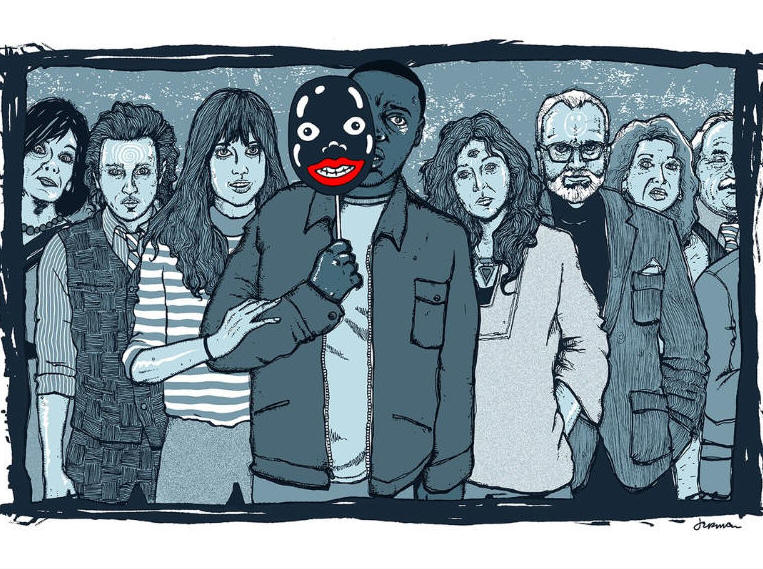
More art inspired by Jordan Peele's horror film "Get
Out".
Jermaine Rogers
The first interaction between Chris and Rose is amorous. Rose positions herself
on Chris’s white-linen bed suggestively as Chris asks her about if she’s told
her parents about him being Black. She mocks Chris’s question with an insult
that operates as barely veiled racist sentiment. Rose has already lied about
her dating history with Black men. It will not, as already discussed here, be
the first lie she tells Chris. Even the way Rose comforts Chris as twilight
descends - in what looks more like a headlock than an embrace - yields clues to
Rose’s true nature.
What “Get Out” does is probe the masks that white people and Black people wear.
There’s a duality in the film’s very title that goes to mind and matter - the
psychological and the physical. “Get Out” means get out of that crazy, violent,
dangerous white suburban atmosphere but it also means “Get Out” of Black
people’s heads, a metaphor for the brainwashing, conditioning and “mental
slavery” Bob Marley once sang about for people to emancipate themselves from.
Multiple masks, multiple mammals, multiple movies
There are references in the film’s artwork, particularly in Rose’s bedroom, to
animals. There’s what looks like a half-woman, half-wolf on the wall, as well
as artwork of the face of a feral-looking white woman in close-up who looks a
bit like Rose, entitled Madison Lecarte (the name of a photographer and
production director on “Get Out”). There’s artwork entitled “Death Cheetah vs.
Matter” - a definition and depiction of the ongoing physical vs. psychological
(brain matter) battle in “Get Out”. The Black man seen as endangered species.
“Those old white women will get you every time,” laughs one Black woman
detective (Erika Alexander) in “Get Out”. When she is told that Chris’s
girlfriend is white the camera captures the detective in close-up - perhaps
there's a flicker of objection on her face at the news. There’s a poster that
says Chris Craine Disco Is Death. Does this mean that Chris is dead? He’s
certainly in danger.
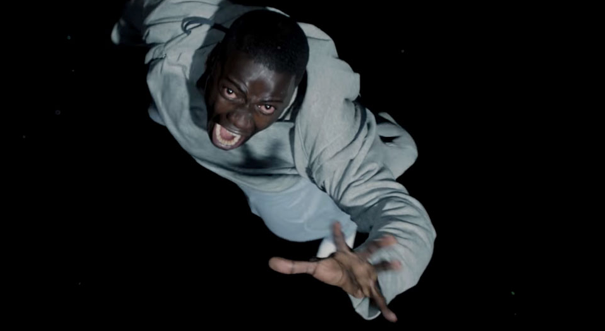
The Sunken Place: Daniel Kaluuya as Chris in Jordan
Peele’s debut film "Get
Out". Universal
“Get Out” is really four movies in one. There’s the objective-subjective horror
movie we are watching. There’s the surrogate audience reaction movie
excellently marshaled by Lil Rel Howrey as Rod the TSA officer and Chris’s best
friend. And there’s the internal movie of Chris silently observing and taking
photos of what he is experiencing. This is a quiet, personal movie that could
be Chris’s own private photo journal essay. The fourth is our own individual
experiences of Mr. Peele’s stunning film.
Because of this layering of movie even before story itself “Get Out” has
different perspectives of entry and existence for its major characters. Since
Rod is removed from the first film (Chris’s experience) he can look with fresh
eyes at the terrifying predicament his friend is in. He can reflect and provide
comic relief to it. Chris cannot see the trouble he is in until late on because
he is in too deep. The third experience, Chris’s personal inner monologue
remains just that, while our “fourth” experience of the collective “Get Out”
depends on who we are and what we bring to it.
The eyes have it
Eyes, mirrors, pictures, screens and seeing are important variables in “Get
Out”. Eyes are perspective and possessory in this film, a stamp of the
beholder. Eyes hypnotize. Eyes warn. A blind art dealer speaks of seeing.
Chris uses his cellphone camera and professional camera as additional eyes,
extra ways of seeing. Walter the groundskeeper has penetrating eyes. His eyes
are fixed directly at us as he runs towards Chris in the middle of the night.
Walter is seen observing Chris’s arrival into this strange white family’s
mansion. Chris’s eyes connect with those of a dying deer, which literally
become a deer in headlights moments before. Chris will become that same deer in
headlights later on in close ups of his eyes widened in frozen, panic-stricken
terror at his unholy predicament.
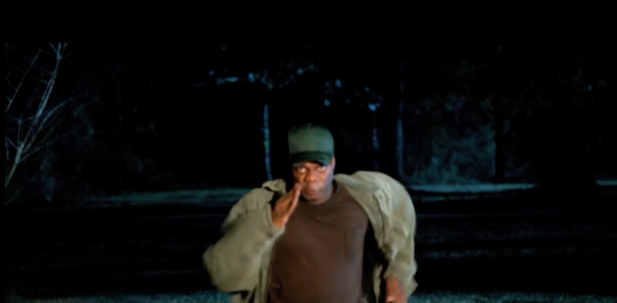
Run Rabbit Run: Marcus Henderson as Walter in Jordan
Peele’s debut film "Get
Out". Universal
People in “Get Out” are constantly observed or being observed as the observe.
The white people at the party inside the Armitage mansion pause in unison to
suddenly look up at Chris in after he has ascended a staircase. Chris is
reflected in a mirror. Rose is looking through a glass display of donuts early
on. Dean and Rod wear eyeglasses. Missy hypnotizes some by boring holes
through them with her eyes and a curt flick of the head. Silver spoons are
required in special instances. Georgina is seen looking through a window and we
see her reflection as she does in one scene in particular. Chris’s cellphone
captures a picture of Logan aka Andre (Lakeith Stanfield) and the flash blinds
him.
Chris has several visions, perceptions and dreams as seen in his mind’s eye and
in our different perspectives of him. Chris sees himself and sees the Armitages
looking down at him in his “sunken place”. In “Get Out” Chris is a
three-dimensional figure, a fully realized human being - a fully-realized and
complete Black man - an utter rarity in a Hollywood horror film. As in war
films Black characters are usually knuckleheads looking to be put out of their
misery with the quickness. Not here. Chris is treated humanely by Mr. Peele,
as are all the Black characters in “Get Out” who in most other movies would be
cannon-fodder or throwaways. There is meaning to the Black characters who exist
in “Get Out”. They have a purpose, a power, a pain and history.
There are many angles and perspectives. Mr. Peele captures sight, vision,
perception and depth, particularly where Chris is concerned. He throws you off
at times. You think something will jump out of the darkness at a character but
most often it does not. Chris is given residual guilt over powerlessness to
prevent or intervene in his mother's death. I couldn't help thinking of
the mental anguish in some Black communities that dates back to enslavement when
women were being raped by white men while Black men were helpless to stop it.
This deep pain and anger during enslavement led to mistrust and hostility
between some Black men and women. Some of this lingers today.
"Get Out" rings so deep not only because of real-life events and centuries’ long
histories - but also its unmistakable look at how power, white privilege and
white supremacy intersect to either doom or protect Black people. Rose saves
Chris from having to show his state ID to a white police officer who solicits it
on the highway, a road paved with a dead deer that Jeremy probably flung from
deep in the bushes. Later Rose will attempt to ensnare Chris at the hands of
another police officer when she cries for help.
Jeremy is hailed for his "wrangling" methods (presumably animal wrangling).
Dean auctions off Chris and we see a large photo of Chris with his camera.
There are multiple photos of Black men throughout "Get Out" projected on
screens, walls or phones.
People are framed on television screens - in short there is constant
surveillance in “Get Out”, including by TSA agent Rod, who is doing detective
work to break a case that the local police aren’t interested in (since, after
all, the notion of missing Black men is treated literally as a joke in a society
predisposed to fear and distrust them.) Rod is like a movie fan who
literally steps through the screen to join the film he's been watching already
in progress and stop it in its tracks with humor and diligence as a fourth-wall
breaker. As a TSA man he's actually investigating a terror that is only
getting the kind of attention it should in the media: the terrorist attacks
Black men and women face just walking down the street.
Rod is a man of the people and an excellent bullshit detector.
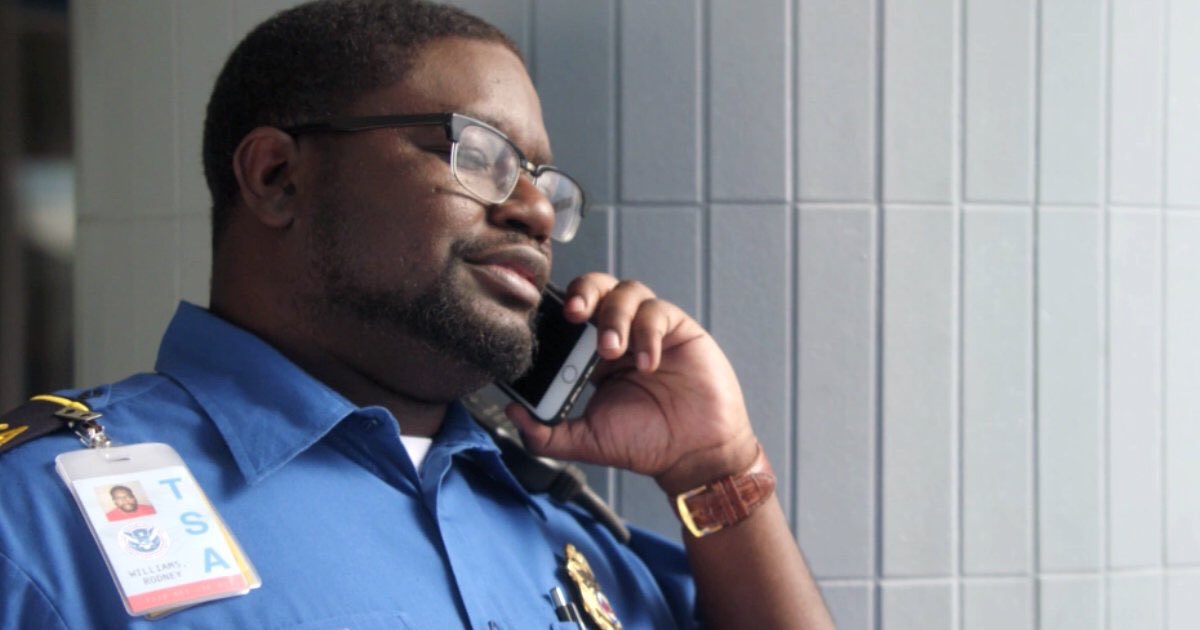
Common sense working stiff: Lil Rel Howrey as Rod in "Get
Out". Universal
“Get Out”, now a cultural touchstone in America, gives us multiple angles on
race, racists and stereotypes about sexual interaction between Black men and
white women - as well as perspectives of Black men both observed and observing.
These abundance of visions reinforces a need to tell narratives from the
perspective of Black men and women. Whether or not those stories get taken
seriously is another matter. One thing is certain: millions of people in
America are flocking to see “Get Out” and that is proof the film is being taken
seriously. As of the writing “Get Out” has made $78 million. Hollywood can’t
afford to take films by Black filmmakers for granted any longer.
"Get Out" is currently playing across the United States and Canada.
COPYRIGHT 2017. POPCORNREEL.COM. ALL RIGHTS RESERVED.  FOLLOW
FOLLOW
MOVIE REVIEWS |
INTERVIEWS |
YOUTUBE |
NEWS
|
EDITORIALS | EVENTS |
AUDIO |
ESSAYS |
ARCHIVES |
CONTACT
| PHOTOS |
COMING SOON|
EXAMINER.COM FILM ARTICLES
||HOME


 FOLLOW
TWEET
FOLLOW
TWEET








 FOLLOW
FOLLOW